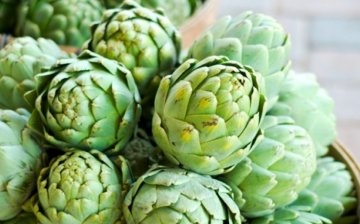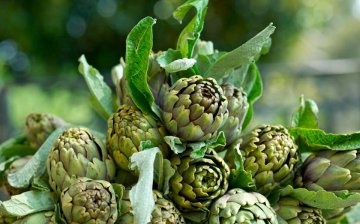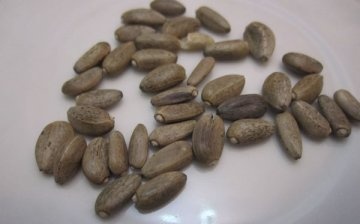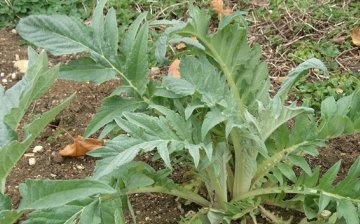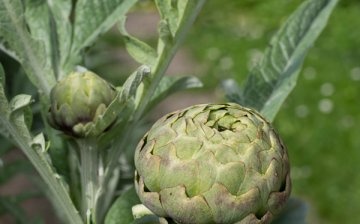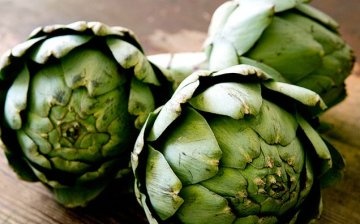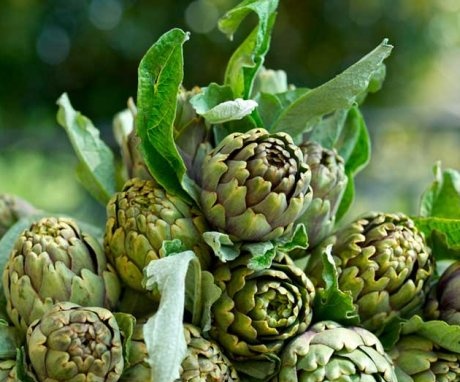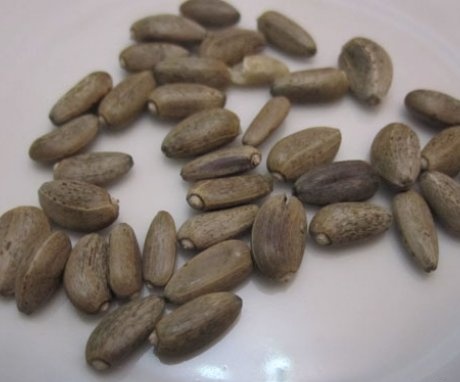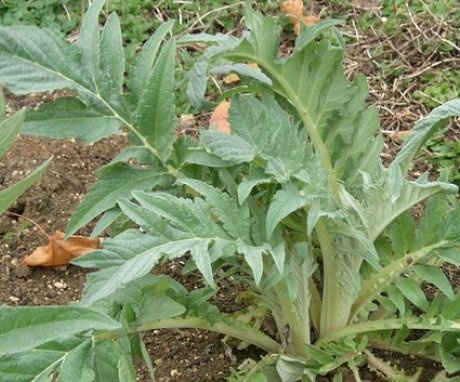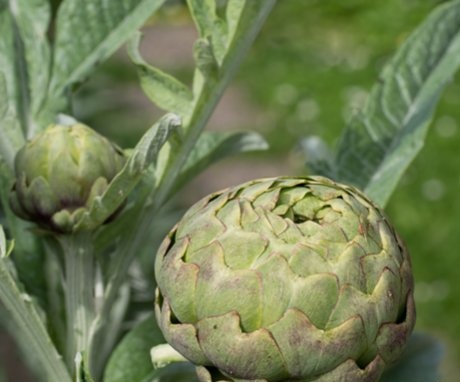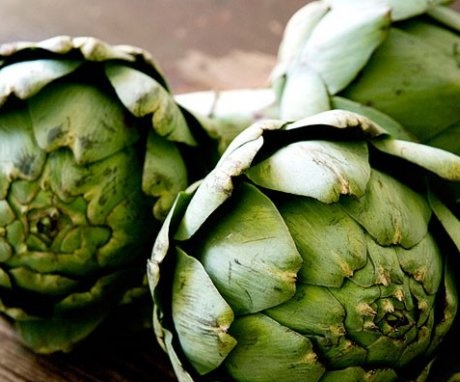Artichoke: growing technology in the garden
Artichoke is a plant that is not often found in our gardens. But in many countries and continents it is considered a delicacy. It contains a huge amount of nutrients. In addition, it tastes good, similar to Walnut.
Content:
- Artichoke: description
- Breeding artichoke
- Growing an artichoke
- Artichoke care
- Using and storing artichoke
Artichoke: description
The artichoke belongs to the Asteraceae genus. The parts of the plant that are eaten look like large buds. They grow on tall perennial plants, reaching a height of 2 m.About 800 cones are formed on the bush, each of which reaches a size of 4 to 8 cm. Artichoke in its normal state, it looks like a rosette of powerful leaves, equipped with sharp thorns. It looks very much like a thistle - a weed with burdock fruits.
Perhaps the weak distribution of the plant is due to the fact that there are still no zoned artichoke varieties. Therefore, foreign varieties have to be grown:
- "Roman purple"
- "Green ball"
- "May"
The artichoke does not tolerate severe frosts. Therefore, in winter, it must be covered or dug up and stored in a cellar. The climate of Ukraine, Central Russia allows you to store the artichoke in the garden under a layer of organic matter: straw, fallen leaves, sawdust. In more northern regions, the plant is hidden for the winter in a dark and cold place where conditions will not cause germination.
Breeding artichoke
You can propagate an artichoke seeds or root layers. But for the second method, you need to have a mother plant. Artichoke nurseries do not breed or cultivate.
There is no one-size-fits-all approach to growing artichoke seeds. Some gardeners believe that they need to be cooked by vernalization - hold before planting at low temperatures. This should result in faster fruiting. Three-quarters of young plants will flower and harvest in the first year after planting. But he may well be the last. Plants spend a lot of energy on fruiting, so they may not tolerate even mild frosts. Vernalization is advisable in cases where you need to get a harvest in the first year, and the plants themselves are not going to grow the next year.
For vernalization in early February, the seeds are placed in a thin layer on moist warm sand.
Cover so that the plants begin to germinate. To do this, you need to wait about a week. The room temperature must be at least 22 ° C. To maintain a sufficient moisture level, the seeds are sprayed with water every day. After they begin to sprout, the box is placed in the refrigerator for 2 weeks. The temperature in the place of detention should be close to 0 ° C. When the ends of the roots darken, the seeds can be sown.
Growing without vernalization requires prior germination... After the seeds have stood in water for a day, they are germinated in the usual way - wrapped in a damp cotton cloth. The temperature is kept the same as during vernalization. In less than a week, the seeds will hatch and can be planted.
Growing an artichoke
The artichoke, despite its external resemblance to a thistle, is very picky about growing conditions. It grows well and bears fruit in fertilizer-rich soil.It needs bright light to grow successfully. Therefore, for growing an artichoke, they choose a cozy, bright place with fertile soil. It should be loose, lightweight, moisture-permeable.
Growing artichoke seedlings:
- Seedlings or layers of artichoke are planted in pre-prepared pits 60 cm deep and 1 m wide.They are prepared at the end of October. Lay a layer of drainage with a height of about 10 cm. It can be made from expanded clay, pebbles, crushed stone, broken brick, clay. A mixture is prepared from equal parts of humus, garden soil, sand with the addition of peat. Lay on a drainage layer. This amount of fertilizers and nutrients will be sufficient for long-term cultivation of an artichoke. Before planting seeds or seedlings, it must settle and settle. The pits are prepared so that the distance between them is at least 70 cm.
- Sprouted or vernalized seeds are sown in boxes filled with the same mixture. Keep it moist at a temperature of about 20 ° C. In 2 weeks after sowing, they will germinate and form the first true leaf. During this period, the plants need dive - transplanted into another dish. In this case, the root tip usually breaks off. If this does not happen, they tear it off manually. Seedlings are planted in separate peat-humus pots or glasses. Their size should be at least 0.5 liters, because the seedlings by the time of planting will be quite impressive in size.
- Seedlings usually take root well. It needs to be watered regularly, avoiding drying out. After 2 weeks, it is advisable to feed the seedlings. Alternate watering with a 10 percent solution mullein and mineral fertilizers.
- Before planting, the seedlings need to be hardened (as tomato, pepper). The box with the installed plants is taken out into the street during the day, constantly accustoming to the effects of wind, sun and low temperatures. The time spent outdoors is constantly increasing and by the time of planting, young artichokes must fully adapt to the weather conditions.
The time for planting plants in open ground depends on the climatic conditions. If warm weather sets in in May, and frosts are not expected, you can plant seedlings in open ground. But it is better to prepare shelters for them, which can be used in case of a sharp drop in temperature. Shelters are necessary if late return frosts occur even at the beginning of summer. They can damage the growing point.
Moisten the soil in pre-prepared pits. 2 plants are planted in each of them. They should not be deeply buried. Root system a young plant is highly developed, so they are well adhered to the soil, without requiring props and hilling.
Reproduction by layering, on which there are several leaves, is carried out in several stages:
- They dig a hole next to the plant.
- A dig is made by placing a shovel under the appendix.
- Cut off the root.
- Treat the cut site with crushed coal or other disinfectant.
- The shoot is planted in a pre-prepared hole.
In February, you can cut off the shoot from the plant stored in the cellar, treat it with a growth stimulant and plant it in a bowl with wet sawdust. Cover with a glass jar, constantly moisten. Remove the jar after the plant has stretched 5 cm.
Artichoke care
The planted plants do not require special care:
- They are watered in the evening every other day little by little or 2 times a week, adding up to 5 liters of water at a time. It is not worth overmoistening the soil, as well as allowing it to dry out. The ability of the soil to pass moisture, the amount of precipitation, and the proximity of groundwater are taken into account.
- The next day after watering, the soil around the plants is loosened, breaking the formed crust and destroying weeds... The right amount of air is supplied to the roots of the plant, and the weeds will not be able to drown the plants until they start growing.
- Top dressing has a positive effect on the condition of the plant.They are carried out in the same way as during the period of growing seedlings. After each feeding, watered. Another type is added - foliar dressing. To do this, spray the plants with a solution of fertilizers made on the basis of superphosphate (1 tsp), wood ash (1 hour), potassium chloride (3 hours). This type of feeding increases the amount of trace elements in the product and prevents damage from aphids and caterpillars.
If the plants were grown with preliminary vernalization, then most of them will bloom and yield a harvest. There is no need to wait.
When flower stalks appear among the leaves of the artichoke, you need to carefully monitor their development.
After 2 weeks, the top of the bud will open slightly. This indicates that they are ready to eat. To make the heads grow larger, you need to regulate their number. For this, the plant is left with up to 3 peduncles. Up to 4 baskets are left on each of them. Artichoke heads do not grow to readiness simultaneously. They are cut off, capturing part of the peduncle.
The plant should not be allowed to bloom. The heads, on the top of which blue petals have appeared, become very hard and are not suitable for cooking.
Using and storing artichoke
Cut artichoke heads can be stored for up to 3 months. For this, the room temperature must be about 1 ° C. If you raise it to 12 ° C, then the artichoke will be usable for up to 4 weeks. Its use increases immunity.
Young heads (up to 4 cm in size) are eaten completely, in larger ones they eat the bottom and bases of the scales.
Artichoke leaves are used to treat diseases of the genitourinary system, cleanse the liver and kidneys. The broth rinse the throat and mouth with stomatitis. Artichoke infusions help in the treatment of dermatitis.
More information can be found in the video:



